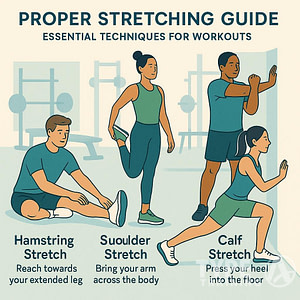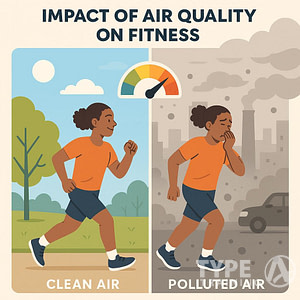If you’re a parent, you know that keeping your kids healthy and active is important. But did you know that regular exercise and physical activity can benefit your child in more ways than just physical health? In fact, there are many surprising benefits of kids fitness that go beyond just keeping your child in shape.
According to the Centers for Disease Control and Prevention (CDC), regular physical activity can improve your child’s academic performance, build strong muscles and endurance, and reduce the risk of depression. Additionally, physical activity can improve your child’s coordination, strength, and muscle control, as well as help them maintain a healthy body weight. But the benefits don’t stop there!
As Dr. Daniel Hsu, a pediatrician at Children’s Hospital Los Angeles, explains, “Physical activity is essential for kids because it helps them develop not only physically but also mentally and socially.” So, if you’re looking for ways to help your child thrive, consider incorporating regular physical activity into their routine. Not only will it benefit their physical health, but it can also help boost their mental and social well-being as well.
Key Takeaways
- Kids fitness has many physical and mental benefits beyond just keeping your child in shape.
- Regular physical activity can improve academic performance, build strong muscles and endurance, and reduce the risk of depression.
- Physical activity is essential for kids because it helps them develop not only physically but also mentally and socially.
Physical and Mental Benefits of Kids Fitness
Regular physical activity is essential for children’s overall health and well-being. Engaging in fitness activities can provide numerous benefits, both physically and mentally. In this section, we will explore some of the physical and mental benefits of kids’ fitness.
Popular posts:
Physical Benefits
Physical activity helps children develop strong muscles and bones, maintain a healthy body weight, and reduce the risk of obesity, diabetes, and other chronic diseases. It also improves their cardiovascular health, making their heart and lungs stronger and more efficient. According to the American Academy of Pediatrics, children should engage in at least 60 minutes of physical activity per day, including activities that strengthen bones, such as running and jumping.
“Physical activity is important for children’s growth and development,” says Dr. Jennifer Trachtenberg, a pediatrician and author. “It helps build strong bones and muscles, improves coordination and balance, and promotes healthy habits that can last a lifetime.”
Mental Benefits
In addition to physical benefits, regular exercise has been shown to have positive effects on children’s mental health. Exercise releases endorphins, which are natural mood boosters, and can help reduce symptoms of depression and anxiety. It also promotes better sleep, which is essential for overall well-being.
“Physical activity and exercise have been shown to improve self-esteem, confidence, and social skills in children,” says Dr. Trachtenberg. “Team sports, in particular, can help children learn important life skills such as teamwork, communication, and goal-setting.”
Research has also shown that physical activity can improve academic performance, attention, and memory in children. The Centers for Disease Control and Prevention (CDC) reports that physically active students have better grades, school attendance, and classroom behavior.
In conclusion, physical and mental benefits of kids’ fitness are numerous. Engaging in regular physical activity can help children develop healthy habits, build strong muscles and bones, and reduce the risk of chronic diseases. It can also improve their mental health, boost their mood, and promote better sleep. Encouraging children to engage in a variety of activities, including team sports, can help them develop important life skills and improve academic performance.
Getting Kids Active
Encouraging kids to be physically active is essential for their overall health and well-being. The benefits of physical activity go beyond just physical health, as it can also improve mental health, cognitive function, and social skills. Here are some guidelines and tips to help get your kids moving and stay active.
Guidelines for Physical Activity
According to the American Academy of Pediatrics, children and adolescents should aim for at least 60 minutes of moderate to vigorous physical activity every day. This can include activities such as running, swimming, biking, dancing, or playing team sports. Strength training exercises can also be beneficial for children and adolescents, but it should be done under the supervision of a qualified professional.
It’s also important to encourage a variety of activities to promote different aspects of physical fitness, such as aerobic endurance, muscular strength, and flexibility. Bone-strengthening activities like running, jumping, and gymnastics are especially important for children and adolescents to promote healthy bone development.
How to Encourage Kids to Stay Active
Making physical activity fun and enjoyable is key to encouraging kids to stay active. Here are some tips to help get your kids moving:
- Provide opportunities for free play and unstructured physical activity, such as playing outside or going on hikes.
- Encourage participation in organized sports or fitness clubs to promote teamwork, communication, and social skills.
- Set achievable goals and celebrate progress to help build confidence and motivation.
- Be a positive role model by prioritizing physical activity in your own life and participating in activities together as a family.
- Limit screen time and encourage physical activity as a healthy habit.
- Provide access to resources and equipment to support physical activity, such as sports equipment or community fitness programs.
Research has shown that physical activity can improve self-esteem, confidence, and mental health in children and adolescents. As Dr. David Satcher, former Surgeon General of the United States, once said, “Physical activity is one of the most important things you can do for your health.” By encouraging your kids to stay active, you can help promote a healthy lifestyle and set them up for a lifetime of well-being.
Sources:
- American Academy of Pediatrics. (2018). The Benefits of Physical Activity in Children and Adolescents. Retrieved from cdc.gov
- Centers for Disease Control and Prevention. (2021). Physical Activity for Children and Adolescents. Retrieved from https://www.cdc.gov/physicalactivity/basics/children/index.htm
Types of Kids Fitness Activities
When it comes to kids’ fitness activities, there are a variety of options to choose from. Here are some of the most popular types of activities that can help children stay active and healthy:
Team Sports
Team sports are a great way for kids to learn about teamwork, communication, and sportsmanship. Some popular team sports for kids include basketball, soccer, and baseball. These sports can help improve cardiovascular health, coordination, and strength.
According to the American Academy of Pediatrics, “participation in organized sports provides a chance for young people to increase their activity and develop socially and emotionally.” This can lead to improved self-esteem and confidence.
Individual Sports
Individual sports like swimming, biking, and running can help children develop a sense of independence and self-motivation. These activities can also improve cardiovascular health, endurance, and body composition.
According to the CDC, “regular physical activity can help children and adolescents improve cardiorespiratory fitness, build strong bones and muscles, control weight, reduce symptoms of anxiety and depression, and reduce the risk of developing health conditions such as heart disease, cancer, type 2 diabetes, high
Free Play
Free play is an unstructured form of physical activity that allows children to move and play in a way that feels natural to them. This type of activity can help children develop creativity, problem-solving skills, and social skills.
According to researchers, “free play is essential for healthy child development and well-being.” It can also help children maintain a healthy body weight, improve coordination, and reduce the risk of injuries.
Dance and Movement
Dance and movement activities like ballet, hip-hop, and jazz can help children develop flexibility, coordination, and balance. These activities can also improve cardiovascular health, strength, and endurance.
According to the American Academy of Pediatrics, “dance provides an opportunity for children to develop physical skills, creativity, and self-expression.” It can also help children develop social skills and build relationships with others.
Gymnastics and Yoga
Gymnastics and yoga are great activities for improving flexibility, strength, and balance. These activities can also help children develop mental focus and concentration.
According to the American Academy of Pediatrics, “gymnastics can help improve strength, flexibility, and coordination.” Yoga can also help children develop “healthy habits for physical activity, stress reduction, and relaxation.”
Incorporating a variety of activities into your child’s fitness routine can help keep things interesting and prevent burnout. It’s important to find activities that your child enjoys and that fit their abilities and interests.
As the CDC notes, “children and adolescents should do 60 minutes or more of physical activity each day.” By encouraging your child to stay active and providing them with the resources and support they need, you can help them develop healthy habits that will last a lifetime.
“Physical activity should be fun, not a chore. Find activities that your child enjoys and that they can do with friends or family. This will help them stay motivated and engaged.” – CDC
Sources:
- American Academy of Pediatrics. (2019). The Benefits of Play for Children.
- Centers for Disease Control and Prevention. (2021). Physical Activity Facts.
Creating a Safe and Supportive Environment
When it comes to kids’ fitness, creating a safe and supportive environment is crucial to ensuring their success. This environment should include safety guidelines and support for kids in their fitness journey.
Safety Guidelines
Safety is paramount when it comes to kids’ fitness. Here are some guidelines to help ensure that your child stays safe while exercising:
- Always supervise your child during exercise to ensure they are using proper form and technique.
- Make sure your child wears appropriate clothing and footwear to prevent injuries.
- Ensure that your child stays hydrated during exercise.
- Gradually increase the intensity and duration of exercise to prevent overexertion.
- Always warm up and cool down properly before and after exercise.
- Encourage your child to speak up if they experience pain or discomfort during exercise.
By following these safety guidelines, you can help ensure that your child stays safe while exercising and avoid any potential injuries.
How to Support Kids in Their Fitness Journey
Supporting your child in their fitness journey is crucial to their success. Here are some ways you can support your child:
- Encourage your child to participate in physical activities they enjoy.
- Set realistic fitness goals for your child and celebrate their progress.
- Be a positive role model by exercising regularly yourself.
- Make exercise a family activity to encourage bonding and healthy habits.
- Provide your child with healthy snacks and meals to fuel their workouts.
By supporting your child in their fitness journey, you can help them develop a lifelong love of exercise and healthy habits.
As the National Center on Safe Supportive Learning Environments states, “Creating safe and supportive environments in schools includes emphasizing aspects of the school environment that encourage students to be more engaged in their school life and feel connected to important adults at school and at home.” By creating a safe and supportive environment for your child’s fitness journey, you can help them feel more engaged and connected to you and their physical health.
Sources:
- National Center on Safe Supportive Learning Environments
- Centers for Disease Control and Prevention
Frequently Asked Questions
How does exercise benefit a child’s overall health?
Physical activity is essential for children’s overall health and well-being. Exercise helps to build strong bones and muscles, improve cardiovascular health, and maintain a healthy weight. It also helps to improve sleep, reduce stress and anxiety, and boost mood and self-esteem. According to the Mayo Clinic, “Children who exercise regularly are more likely to continue the habit into adulthood, which can lead to lifelong health benefits.”
What are some psychological benefits of youth sports?
Participating in youth sports can have a positive impact on a child’s mental health. It can help to improve self-esteem, reduce symptoms of depression and anxiety, and increase resilience. According to KidsHealth, “Children who participate in sports are more likely to have a positive self-image and better relationships with peers and adults.”
What are the social benefits of youth sports?
Youth sports can also have a positive impact on a child’s social development. It provides opportunities for children to learn teamwork, communication, and leadership skills. It can also help to build friendships and a sense of community. According to the CDC, “Sports participation can help children develop social skills that will benefit them throughout their lives.”
What are 6 benefits of physical activity for children?
Physical activity has numerous benefits for children, including:
- Improved academic performance
- Reduced risk of depression
- Stronger muscles and endurance
- Improved cardiovascular health
- Better sleep
- Reduced risk of chronic diseases
What are the physical benefits of youth sports?
Youth sports provide opportunities for children to engage in physical activity and improve their overall health. It helps to build strong bones and muscles, improve cardiovascular health, and maintain a healthy weight. According to the CDC, “Regular physical activity can help children and adolescents improve cardiorespiratory fitness, build strong bones and muscles, control weight, and reduce the risk of developing health conditions such as heart disease, cancer, and type 2 diabetes.”
Why is physical activity important for promoting good health in children?
Physical activity is essential for promoting good health in children. According to the CDC, “Regular physical activity in childhood and adolescence is important for promoting lifelong health and well-being and preventing various health conditions.” It helps to build strong bones and muscles, improve cardiovascular health, and maintain a healthy weight. It also has numerous psychological and social benefits.
As the saying goes, “Healthy habits start early.” Encouraging children to be physically active from a young age can set them on a path to a healthy and happy life.
“Physical activity should be seen as a daily necessity, not a luxury.” – American Heart Association






